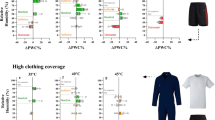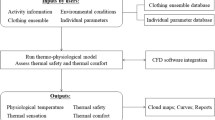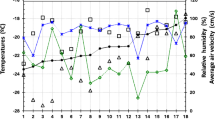Abstract
Objective: To co-ordinate the work of the main European research teams in the field of thermal factors in order to develop and improve significantly the methods presently available for assessing the risks of heat disorders encountered during work in hot conditions. Method: Each item from the required sweat rate model was reviewed on the basis of the most recent literature. A database with 1,113 laboratory and field experiments, covering the whole range of hot working conditions, was assembled and used for the validation. Results: Influence of clothing ensemble on heat exchange: methods and formulas were developed that take into account the dynamic effects associated with forced convection and the pumping effect associated with body movements and exercise. Prediction of the average skin temperature: the model used in the required sweat rate standard ISO 7933 was extended to cover more severe conditions with high radiation and high humidity and different clothing and take into account the rectal temperature for the prediction of the skin temperature. Criteria for estimating acceptable exposure times in hot work environments: criteria were reviewed and updated concerning the maximum increase in core temperature and the acceptable water loss, for acclimatised and non-acclimatised subjects. These limits are intended to protect 95% of the population. Measuring strategy: a strategy was developed to assess the risks in any working situation with varying conditions of climate, metabolic rate or clothing. A detailed methodology was developed in three stages: an "observation" method for the recognition of the conditions that might lead to thermal stress; an "analysis" method for evaluating the problem and optimising the solutions; and an "expert" method for in-depth analysis of the working situation when needed. Validation: the different results were used to prepare a revision of the interpretation procedure proposed in the ISO standard 7933. We validated the modified approaches using the database. This involved the whole range of conditions for which the model was extended, namely conditions with high and low radiation, humidity and air velocity as well as fluctuating conditions. Based on these results, the predicted heat strain model was developed: it is presently proposed as an ISO and CEN standard.
Similar content being viewed by others
Author information
Authors and Affiliations
Corresponding author
Additional information
Electronic Publication
Rights and permissions
About this article
Cite this article
Malchaire, J., Kampmann, B., Mehnert, P. et al. Assessment of the risk of heat disorders encountered during work in hot conditions. IAOEH 75, 153–162 (2002). https://doi.org/10.1007/s004200100287
Received:
Accepted:
Published:
Issue Date:
DOI: https://doi.org/10.1007/s004200100287




